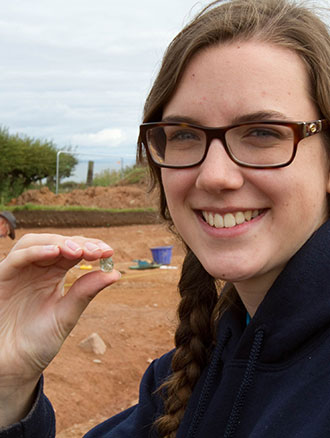August
Newcastle student unearths rare Roman jewellery

A Newcastle University student has discovered a rare piece of rock crystal Roman jewellery during an award-winning archaeological dig.
Daisy-Alys Vaughan, a second-year BA Ancient History and Archaeology student, found the piece which is thought to be the centre piece from an expensive ring dating from the second or third century. The head of a bearded man is carved into the back and filled with white material, possibly enamel. The crystal would have been mounted onto a small piece of bronze, and when originally worn the polished bronze back would have looked like gold through the stone.
The discovery was made during the final stages of the Maryport Temples project in Cumbria, which is being carried out by a team from Newcastle University, supported by local volunteers. The project won the title Current Archaeology Research Project of the Year 2015 in March and featured in BBC2’s Coast series in July.
Since the project started in 2011, the excavation team has spent around eight weeks on site each summer. This year’s dig has yielded more information about the layout of the temples area near the remains of the Roman fort and civilian settlement in fields next to the Senhouse Roman Museum.
Daisy-Alys, 19, from Leicester, said: “This is the second dig which I have taken part in and I never expected to find something so rare. At first I had no idea of the significance of the find as the carved head wasn't immediately noticeable. I couldn't believe it when I later found out how rare the item was, it feels amazing to have been part of finding such an exciting artefact!
“I decided to do a course in archaeology as I've always loved visiting museums and learning about the past through material culture so wanted the opportunity to learn more about the actual process of discovering these objects. After university I want a career relating to museums and heritage so finding such a rare item has encouraged me to pursue this.”
Ian Haynes, Professor of Archaeology and project director said: “This year we have been able to demonstrate that the temples formed part of a large monument complex, unlike anything discovered on Britain's Roman frontier to date. The complex was a major undertaking and was dominated by a substantial precinct where many of Maryport's famous altars may once have stood.
“Our aim has always been to find out more about how the famous collection of Maryport Roman altars, unearthed in 1870 and now in the Senhouse Roman Museum, were originally displayed in Roman times.
“In 2011 we found the altars had been used in the foundations for later timber buildings just over the ridge, not ritually buried as previously thought. We think that when they were orginally dedicated to the Roman god Jupiter by commanders of the fort each year - which we know from the inscriptions - a number of them would have been displayed together on the cobbled precinct.
“We’ve also found more evidence from ditches below the precinct for a temporary camp, which appears to date from before Hadrian's Wall was constructed, evidence for the movement of Rome's campaigning armies. Site director Tony Wilmott first suggested that there might be indications of an early camp back in 2013, but the proof of his hypothesis came this year.”
The project was commissioned by the Senhouse Museum Trust and supported by Newcastle University. The landowner of the site is the North of England Civic Trust (NECT), which has co-operated with Senhouse Roman Museum and Newcastle University to enable this final excavation to go ahead.
Jane Laskey, manager of the Senhouse Roman Museum said: “It has been a very exciting season and the team will continue to analyse the results of this year's dig and consider the new insights the whole project has brought to our understanding of the Roman empire in Britain.”
published on: 17 August 2015
